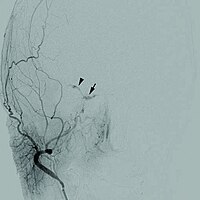
Photo from wikipedia
Few studies have examined the long-term prognosis of Chinese patients with intracerebral hemorrhage (ICH). This study assessed the clinical characteristics and predictors of vascular events occurring within 5 years after ICH.… Click to show full abstract
Few studies have examined the long-term prognosis of Chinese patients with intracerebral hemorrhage (ICH). This study assessed the clinical characteristics and predictors of vascular events occurring within 5 years after ICH. We included consecutive patients diagnosed with first-ever ICH between June 2013 and December 2014. Based on follow-up data (collected until December 2019), we used multivariable logistic regression to examine the clinical characteristics and long-term predictors of vascular events (including recurrent ICH, ischemic stroke, and acute coronary syndrome) in patients who survived more than 30 days after ICH. Across the 307 patients in our analysis, the 5-year mortality rate was 28.01%. Within 5 years after ICH, major vascular events were observed in 62 patients (17.82%, 95% CI 13.78-21.82%). We observed high incidence of recurrent ICH (8.91%) and ischemic stroke (10.06%), but low incidence of acute coronary syndrome (1.15%). Most cases of recurrent ICH (80.65%) occurred within 3 years after ICH. Age ≥56 years and history of ischemic stroke or transient ischemic attack (TIA) were identified as predictors of cardiovascular and cerebrovascular events. ICH survivors are at high risk of both cardiovascular and cerebrovascular events, especially older patients (≥56 years) and those who experienced ischemic stroke or TIA prior to their first ICH. Recurrent ICH is more likely to occur within the first three years after first ICH than at later times. Clinicians should monitor patients closely for adverse events, particularly during the first three years after initial ICH.
Journal Title: Journal of Clinical Neuroscience
Year Published: 2021
Link to full text (if available)
Share on Social Media: Sign Up to like & get
recommendations!